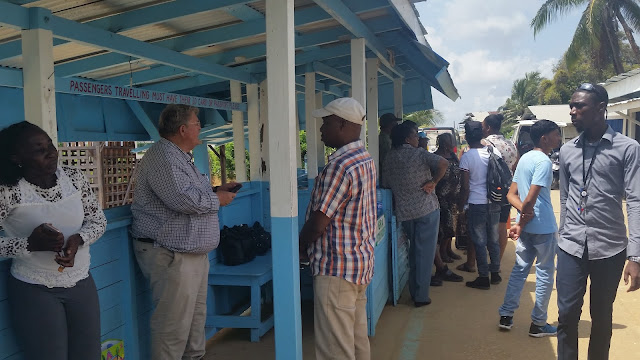Scott Haskell Looks Back on his F2F Assignment in Guyana
In September 2019 I travelled to Guyana to participate in USAID’s Farmer-to-Farmer program, implemented by Partners of the Americas. What a wonderful three weeks I spent in this tropical paradise! The Animal Health Unit of the Guyana Livestock Development Authority (GLDA) is responsible for implementing sanitary measures to mitigate the introduction and spread of disease in the country that could affect animal and public health. As a member of the World Organization of Animal Health and recognizing its obligation of fair trade under the World Trade Organization, a high level of competence is necessary for the GLDA to develop Sanitary and Phytosanitary measures.
To develop the necessary capacities, I was asked to volunteer under the Farmer-to-Farmer program to provide technical assistance to the GLDA in the development of disease risk analysis protocols and to help develop animal quarantine systems. The assignment was quite interesting from the start. The nation is beautiful. Despite being neighbored by Spanish-speaking countries, Guyana has retained English as its official language. This is because even though it is in South America, Guyana is considered a Caribbean nation.
Just under three-quarters of Guyana is made up of dense rainforest. The capital of the nation, Georgetown, is where the majority of the population lives, also along the coast. Georgetown is surrounded on one side by rainforests, and on the other by the Atlantic Ocean. There was lots of bird activity on my morning walks to the market. Fantastic colors.... They even have toucans and parrots! It rained pretty hard sometimes, and the roofs are all metal so the sound was quite spectacular. I noticed that most homes collect rainwater in tanks for conservation.
Following the abolition of slavery in Guyana, plantation workers were needed; this led to a high immigration rate of East Indians into the country. As a result of this, nearly half of Guyana’s population are of East Indian origin and 36% of the remaining population are of African descent. Amerindian populations make up the rest. While in the country, I took the opportunity to visit dozens of Guyana folks across the nation and discovered there is consistent confidence that Guyana’s best days are still ahead. There is confidence in Guyana and for Guyana! Guyanese people are warm, welcoming and positive.
The first week of my assignment was spent traveling to the far corners of Guyana, visiting members of the GLDA team. What wonderful and exciting folks I met! My project was really well received by my hosts, members of the GLDA teams, local veterinarians and livestock producers. Once I was done working in the field, I spent an extensive amount of time training the quarantine agents and officers, as well as members of the Guyana Veterinary Medical Association. The groups here are excellent to lecture to and the participant cross-exchange and sharing is an outstanding part of the Guyanese educational process. They are really open to sharing and enjoying information from other parts of the world.
As a new volunteer to Guyana, the first five minutes of my lecture each morning provided a golden opportunity to get your Guyanese participants to sit up and pay attention (they would even bring me fruit like bananas and guavas). I started with the obvious – explaining my objectives for the lecture and outline learning outcomes. I began each lecture with passion and it always caught on: The participants reciprocated with Caribbean enthusiasm. I found that Guyana folks engage with passion and knowledge right from the outset. What a pleasure to work alongside these folks. I tried to engage, excite, challenge and create expectations while in fact that is what happened to me! I learned as much as I hope they did. My lectures used interesting or little-known facts to spark curiosity right from the very beginning, and it worked. Scanning the room on a regular basis gave me a good indication of how engaged my participants appeared to be.
As we all know, one of the crucial elements to a successful lecture is the planning process. Each night in my hotel room I worked on salient topics that I thought veterinary professionals within Guyana would need to embrace and incorporate into their daily practice. I worked on being fully confident about the content, structure and delivery of the material before I began, so organization was a key part of my successful lecturing.
Each day I shared Creole food with the participants. Boy what a joy that is! Really yummy meals varying daily! I didn’t want to come home. Overall, I had a wonderful trip volunteering in Guyana. It is my second trip to the garden nation and I enjoyed this one even more than the first. Great people and a wonderful Caribbean community, I can't wait to go back!






.png)

Comments
Post a Comment